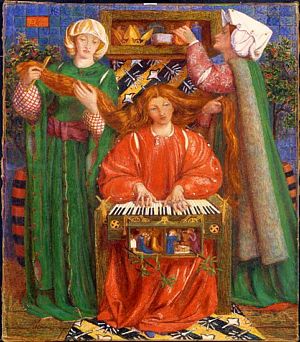-ћетки
-–убрики
- ј–“»Ќџ –ќ——≈““» (16)
- ѕ–ќ«≈–ѕ»Ќј PROSERPINA (3)
- BEATA BEATRIX (2)
- LADY LILITH@SYBILLA (2)
- ѕи€ де “оломеи (1)
- BOCCA BACIATA (1)
- «≈Ћ®Ќџ≈ –” ј¬ј (1)
- REGINA CORDIUM QUEENG of HEARTS (1)
- THE BLESSED DAMOSEL Ѕлагословенна€. (1)
- ASPECTA MEDUSA (1)
- ƒама в окне. The Lady of the Window. (1)
- ¬идение ‘иаметты. Vision of Fiammetta. (1)
- ƒневна€ мечта. The Day Dream и The Bower Meadow (1)
- „ј—“» “≈Ћј. THE BODY PARTS. (13)
- Ќј√ќ“ј ¬ »— ”——“¬≈ (5)
- ќЋЋ≈ ÷»я ‘≈“»Ў»—“ј (4)
- —“ќѕџ » »—“» скованные одной цепью. (3)
- ќЌ –≈“Ќџ≈ Ќќ∆ ». (1)
- ћќƒ≈Ћ» –ќ——≈““» (11)
- ƒ∆≈…Ќ ћќ––»— Ѕ®–ƒ≈Ќ JANE MORRIS BURDEN (4)
- ‘анни орнфорт (2)
- јЌЌ» ћ»ЋЋ≈– ANNIE MILLER (1)
- јЋ≈ —ј ¬ј…Ћƒ»Ќ√ ALEXA WILDING (1)
- ЅјЋ≈“ — “–≈“№≈√ќ я–”—ј. (9)
- HANNIBAL LECTER (5)
- ристина –оссетти (5)
- ристина –оссетти Christina Rossetti поэзи€ poems (3)
- ART DECO (4)
- √јЋ≈–≈я Ћ≈ћѕ»÷ ќ… (1)
- “јћј–ј Ћ≈ћѕ»÷ ј (1)
- „“ќ ¬ »ћ≈Ќ» “≈Ѕ≈ ћќ®ћ? (4)
- Ёлизабет —иддал (4)
- ∆»«Ќ№ ј–“»Ќ. (3)
- мо€ живопись. My paintings. (3)
- ѕќЁ«»я (1)
- јльфред “еннисон (1)
- —ѕ»—ќ ’”ƒќ∆Ќ» ќ¬ (1)
- ‘–»Ќј —≈ћ»–јƒ— ќ√ќ (1)
- Ќ»√ј ќ –ќ——≈““» (1)
- ћјЌ№≈–»«ћ (1)
- —писок работ –оссетти. The full list of Rossetti's (1)
- DOUBLE WORKS (1)
- јЌќЌ—џ –”Ѕ–» (2)
- ѕ–≈–ј‘јЁЋ»“џ (38)
- ¬—≈ ѕ–≈–ј‘јЁЋ»“џ (11)
- —ѕ–ј¬ » по ѕ–≈–ј‘јЁЋ»“јћ (4)
- ѕ–≈ƒ“≈„» (3)
- ѕ–≈–ј‘јЁЋ»“џ ¬ –ќ——»» (1)
- –ќ——≈““». ROSSETTI. (50)
- –ќ——≈““» ∆»«Ќ№ ROSSETTI LIFE (43)
- ƒжон ”иль€м ѕолидори и его ¬ампир (1)
- –ќ——≈““» —ќ —“ќ–ќЌџ (1)
- пќЁ«»я –ќ——≈““» (1)
- ћ”«≈» —ј…“џ. MUSEUMS. SITES. (15)
- ћ≈“–ќѕќЋ»“≈Ќ (3)
- ’”ƒќ∆≈—“¬≈ЌЌџ… ћ”«≈… ƒ≈Ћј¬ј–ј. (3)
- ћќ… Ё–ћ»“ј∆ (3)
- Ћ»¬Ћ≈Ќƒ— »… ћ”«≈… (1)
- ћќ» –ќћјЌџ (58)
- »— ј“≈Ћ№ 2 (41)
- роман "”читель" (9)
- ј« ≈—ћ№ (3)
- Ё «»—“≈Ќ÷»я (1)
- Novels, English versions. (1)
- мои стихи (1)
- ј—‘јЋ№“ (1)
-ћузыка
- гуд бай дарлинг
- —лушали: 169 омментарии: 0
- полный закат
- —лушали: 188 омментарии: 1
-ѕоиск по дневнику
-ѕодписка по e-mail
-»нтересы
-—ообщества
-—татистика
–ќ——≈““» 1856 - 1857. |
–ќ——≈““» 1856 - 1857.
1856 - 1857.
1856
Dante's dream at the Time of the Death of Beatrice. Walker Art gallery - Liverpool, UK
1857
1.A Christmas Carol Watercolour and gouache on paper. Fogg Museum of Art, Harvard University, Cambridge, MA, USA.
2.Before the Battle (1857-58)
3.The Blue Closet Watercolour on paper. Tate Gallery, London, UK.
4.The Damsel of the Sanct Grael
5.The Lady of Shalott (from the Moxon Tennyson)
6.St. Catherine 1857 Oil on canvas. Tate Gallery, London, UK
8.The Tune of Seven Towers Watercolour on paper. Tate Gallery, London, UK
9.The Wedding of St. George and the Princess Sabra Watercolour on paper. Tate Gallery, London, UK.
10. ћари€ ћагдалина.
11.–ождественский гимн. 1857
Christmas Carol
12.—эр √алахард в разрушенной часовне. Sir Galahad at the ruined Chapel

13. Ёскиз √иневры дл€ "—эр Ћанселот в королевской комнате"
Study of Guinevere for "Sir Lancelot in the Queen's Chamber"
14. —эр “ристам и ѕрекрасна€ »зольда пьющие любовное зелье.
Sir Tristram and La Bella Yseult Drinking the Love Portion.
ѕ€ть его иллюстраций включены в 1857 Moxon Tennyson. ¬ июле выставил восемь работ на выставке прерафаэлитов на Russell Place. ƒо но€бр€ работал над фресками Oxford Union
¬ 1857 году в ќксфорде он влюбилс€ в семнадцатилетнюю ƒжейн ЅЄрден, но в 1859 году она выходит замуж за ћорриса. ’от€ любовь к Ћиззи охладела, но его отношени€ к —иддал и ЅЄрден отвечают самым строгим стандартам того времени.
јнтонио ‘редерик ќгастас —эндс (англ. Antonio Frederic Augustus Sands) получил известность благодар€ карикатуре на картину ƒжона Ёверетта ћилле «—эр »зюмбрас» в 1857 году. ’удожник вместо лошади поместил осла, помеченного буквами «J. R., Oxon» (J. R. — ƒжон –Єскин, Oxon — ќксфорд), сверху сидел ћилле в рыцарских доспехах, а двое маленьких детей спереди и сзади изображали товарищей ћилле по Ѕратству прерафаэлитов ƒанте √абриэл€ –оссетти и ”иль€ма ’олмана ’анта. ѕароди€ называлась «Ќочной кошмар», «A Nightmare».
ак ни странно, —эндис и –оссетти стали близкими друзь€ми, —эндис одно врем€ даже жил в доме –оссетти в „ейни-¬ок („елси). ћногие картины —эндиса написаны под сильным вли€нием –оссетти, впоследствии обвин€вшего его в плагиате.
¬ но€бре 1856 года –оссетти пригласил “омаса ѕлинта в студию ‘орда ћэдокса Ѕрауна посмотреть "“руд" картину он хотел купить, но умер.
A Christmas Carol
1857-1858
The Wedding of St. George and the Princess Sabra.
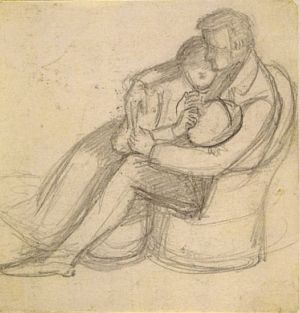 ѕара на этом наброске расслаблена и фигуры несколько бесформенны, в то врем€ как в окончательном варианте фигура √еорги€ угловата и определЄнна.
ѕара на этом наброске расслаблена и фигуры несколько бесформенны, в то врем€ как в окончательном варианте фигура √еорги€ угловата и определЄнна.
ƒјЌ“≈ √јЅ–»ЁЋј –ќ——≈““». —¬јƒ№Ѕј —¬я“ќ√ќ √≈ќ–√»я » ѕ–»Ќ÷≈——џ —јЅ–џ
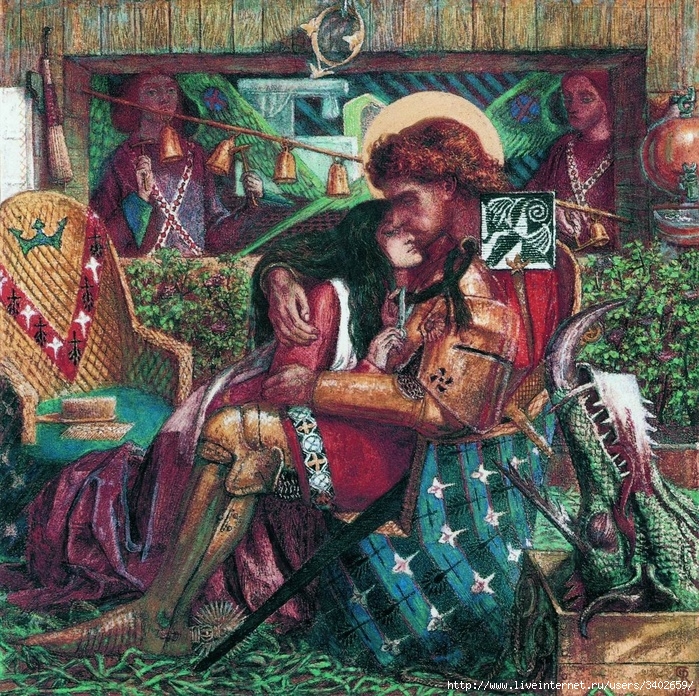
–оссетти работал над акварелью в ќксфорде, где жил вместе с ћоррисом и ЅЄрн-ƒжонсом.
Water color painted in 1857, and exhibited in 1858 at Liverpool Academy. Owned by George Rae. St. George appeared in Syria just in time to rescue Princess Sabra, daughter of the King of Syria, from being sacrificed to the dragon. St. George is restling from having slain the dragon, while the Princess, now wholly his, leans on his breast, cutting off a long dark lock of hair to bind upon his helmet. One of Rossetti's early water colors beautifully executed. The dragon's head in the box, the wealth of detail and pattern of the design, and the rich, golden coloring are striking.
Ќа плече у √еорги€ ailette.
The ailette (French language for little wing) was a component of thirteenth century knightly armour. Usually made of plate or parchment, ailettes were thick, quadrangular pieces of leather or wood that attached to the shoulders by means of silk or leather cord. Ailettes were usually flat and nearly rectangular in shape, and usually decorated with heraldic designs.
Ailettes made brief appearances between 1290 and 1325 before giving way to more protective joint plates that covered the joint gap in the shoulders.
The purpose of ailettes is a matter of disagreement amongst scholars. Some claim that they enhanced protection to the neck, while othersargue that they were used primarily for decorative and heraldic reasons.
»сточник сюжета, возможно, баллада из T. Percy, Reliques of Ancient English Poetry.
ƒракон убит, принцесса —абра причЄсываетс€ и пов€зывает локон на шею √еоргию, на заднем плане брачна€ постель. ¬ это врем€ и –оссетти и его друзь€ подумывали о женитьбе.
St. George and the Princess Sabra was painted by Dante Gabriel Rossetti in 1862. This was the last work that his wife, Lizzie Siddal, posed for before her death. ƒл€ этой акварели позировала —иддал, позже, обратившись к этой теме –оссетти выбрал моделью ƒжейн ЅЄрден.
The Wedding of St. George and the Princess Sabra
∆енитьба —в€того √еорги€ на принцессе —абра.
Having killed the dragon, St George washes the blood from his hands in his upturned helmet. He watches through the window as a crowd carries the dragon's head in triumph. Typically, Rossetti makes the public celebration subordinate to the interaction between St George and Princess Sabra whose life he saved. In an intimate and disturbing scene, she kneels kissing his bloodied hands.
The Blue Closet
1856-1857
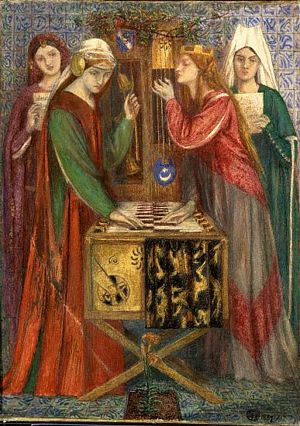
The Tune of Seven Towers
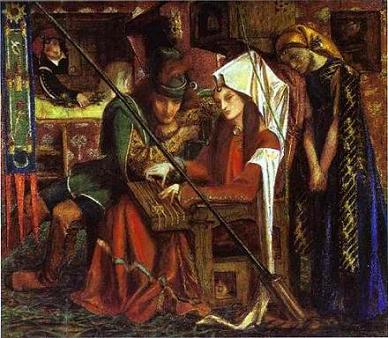
Ќачата весной 1857. омпозици€ развита из рисунка 1853 г "Michael Scott's Wooing". “ема загадочна и, возможно, автобиографична, в это врем€ –оссетти был обеспокоен т€желой болезнью —иддал. (позировала дл€ женщины в красном, играющей на музыкальном инструменте). —лева на вымпеле вышиты те самые семь башен. “ема, возможно, заимствована из сборника средневековых песен, изданных в то врем€ или из любимого ћоррисом средневекового рассказа Aucassin and Nicolete. √олубь в клетке у –оссетти служил эмблемой —иддал.
“Young woman holding an open book, having her hair dressed by an attendant, is seated by a man; both are facing to the left looking towards the figure of Love standing beneath a tree, playing on an instrument. A child sits on the floor to the right of the chair; another figure in the background with head bowed”
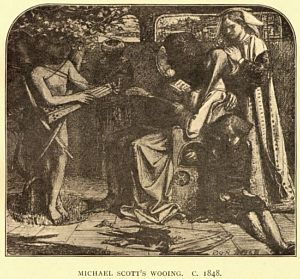
depicts the medieval Scottish magician and astronomer Michael Scott placing a ring on the finger of a young girl.
Michael Scott's Wooing стихотворение –оссетти.
ROSE-SHEATHED beside the rosebud tongue
Lurks the young adder's tooth;
Milk-mild from new-born hemlock-bluth The earliest drops are wrung: And sweet the flower of his first youth When Michael Scott was young.
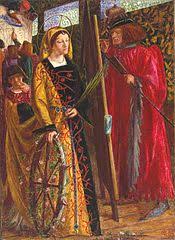 —в€та€ атерина. St. Catherine 1857 единственна€ законченна€ картина маслом между 1850 и 1859 годами.
—в€та€ атерина. St. Catherine 1857 единственна€ законченна€ картина маслом между 1850 и 1859 годами.
Ќа картине –оссетти изобразил богатую даму, котора€ предназнача€ картину в дар церкви, хочет, чтобы св€та€ была срисована с неЄ. артина была заказана –Єскиным, который позже отказалс€ от неЄ, назвав несуразицей. ћодель - Ёлизабет —иддал.
—эр √алахард в разрушенной часовне.
Sir Galahad at the ruined Chapel
Watercolour and bodycolour with areas of gum arabic on paper.
Width: 345 mm
Height: 290 mm
¬ 1855-56 годах –оссетти исполнил п€ть иллюстраций дл€ издани€ “еннисона у ћохона в 1857 году. “ри из них он потом повторил как акварели, это одна из них. “ема заимствована из "—эра √алахарда" “еннисона, в свою очередь вдохновлЄнного ћэлори. ƒанна€ композици€ носит сильное вли€ние Ѕерн-ƒжонса.
In 1855-56 Rossetti made five designs for illustrations to Moxon's edition of Tennyson, published in 1857. Three of these designs of which this is one, he later carried out in watercolour. The subject is dervied from Tennyson's 'Sir Galahad', inspired by Malory. The four other subjects were 'The Lady of Shalott', 'Mariana in the South' and two from 'The Palace of Art'. This composition shows the strong influence of Burne-Jones.
Ёта акварель иллюстрирует "—эра √алахарда" “еннисона: ћеж влажных стволов мерцание, слышу звуки гимна, затем подъезжаю к тайному св€тилищу, слышу голос, но никого нет, скамьи пусты, двери распахнуты, тонкие свечи €рко гор€т. —нежным блеском сверкает алтарный покров, искр€тс€ серебр€ные сосуды... ѕереведу потом.
This watercolour illustrates Tennyson's Sir Galahad -'Between dank stems the forest glows,
I hear a noise of hymns:
Then by some secret shrine I ride;
I hear a voice, but none are there;
The stalls are void, the doors are wide,
The tapers burning fair.
Fair gleams the snowy altar-cloth,
The silver vessels sparkle clean,
The shrill bell rings, the censer swings,
And solemn chants resound between.'
Sir Galahad and an Angel
1857
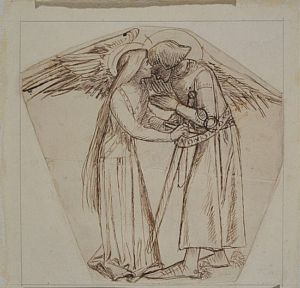
Sir Galahad, Sir Bors and Sir Percival Receiving the Sanc Grael.
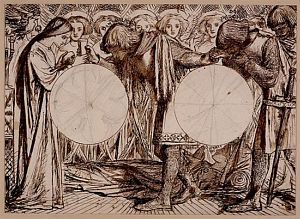
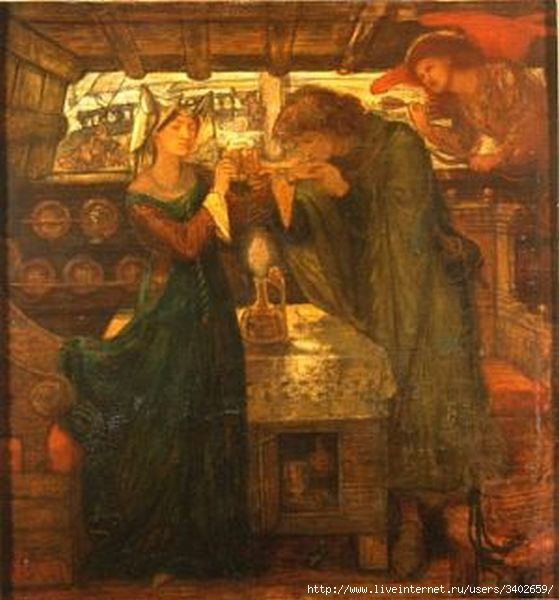
—эр “ристам и ѕрекрасна€ »зольда пьющие любовное зелье.
Sir Tristram and La Bella Yseult Drinking the Love Portion.
The Lady of Shalott 1856-57 (circa)
The Lady of Shallott, 1857
Wood engraving, 35/16 x 31/16 in.
Victoria and Albert Museum, London
»ллюстраци€ к поэме “еннисона. Ћеди из Ўалотта - магическое существо, которое живЄт в замке на острове выше по течению от јртуровского амелота. ≈Є зан€тие состоит в том, что она смотрит в зеркало изь окна своего замка и вышивает то, что видит на гобелене. ≈й запрещено закл€тьем смотреть на внешний мир пр€мо. ‘ермеры, живущие р€дом с островом слышат еЄ пение и знают, кто она, но никогда не видели еЄ. ƒама видит простых людей, влюблЄнные пары, рыцарей, отражЄнными в еЄ зеркале. ќднажды она видит —эра Ћанселота в одиночестве едущего верхом. » хот€ она знает, что это запрещено, выгл€дывает из окна и смотрит на него. «еркало разлетаетс€ на куски, вышивку уносит ветер и Ћэди начинает чувствовать смертоносное действие прокл€ть€. –азражаетс€ бур€. Ћеди покидает замок, находит лодку, пишет на ней своЄ им€, плывЄт по течению и поЄт прощальную песню. Ћодку прибивает к амелоту, жители наход€т лодку и тело, догадываютс€ кто это и груст€т. Ћанселот молитс€ о милосердии божьем к еЄ заблудшей душе.
The Lady of Shalott is a magical being who lives alone on an island upstream from King Arthur's Camelot. Her business is to look at the world outside her castle window in a mirror, and to weave what she sees into a tapestry. She is forbidden by the magic to look at the outside world directly. The farmers who live near her island hear her singing and know who she is, but never see her.
The Lady sees ordinary people, loving couples, and knights in pairs reflected in her mirror. One day, she sees the reflection of Sir Lancelot riding alone. Although she knows that it is forbidden, she looks out the window at him. The mirror shatters, the tapestry flies off on the wind, and the Lady feels the power of her curse.
An autumn storm suddenly arises. The lady leaves her castle, finds a boat, writes her name on it, gets into the boat, sets it adrift, and sings her death song as she drifts down the river to Camelot. The locals find the boat and the body, realize who she is, and are saddened. Lancelot prays that God will have mercy on her soul.
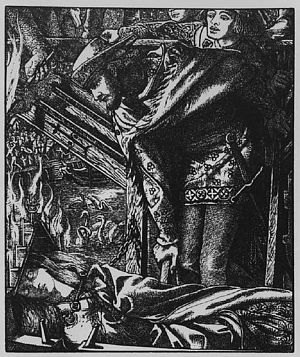
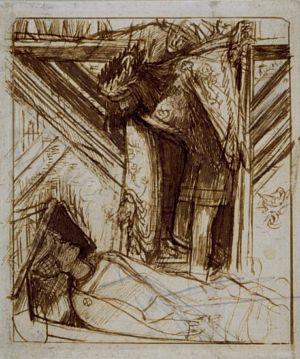
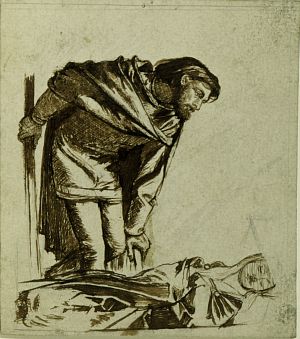
'The Lady of Shalott', Dante Gabriel Rossetti
This engraving was just one of the illustrations to tennyson's poems provided by the Pre-Raphaelite cicle for an edition published by Moxon. 1857.Rossetti's illustrations for tennyson astonished his collegues and had a far- reaching impact on a wider audieence. The project as a hole helped to define the Pre-Raphaelite Brotherhood, creating the impression of a coherent movement at the very momentwhen the artists were going their serarate ways.
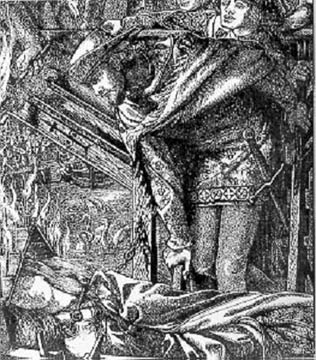 Illustration from 'Poems by Alfred Tennyson', published by Moxon Wood engraving by Dalziel brothers after Rossetti's design,
Illustration from 'Poems by Alfred Tennyson', published by Moxon Wood engraving by Dalziel brothers after Rossetti's design,
published 1857, 9.4 x 8cm, Stephen Calloway
Richly clad, Sir Launcelot leans over the Lady's body as it floats down the river in the barge, lit by flickering candles and a torch held by an unseen figure above. The contrast between the tiny figures of courtiers and the daring close-up of the principal figures adds to the mood of strangeness. The composition may have been suggested by a medieval manuscript illumination from the 14th century 'Lancelot du Lac' in the British Museum.
| –убрики: | –ќ——≈““». ROSSETTI./–ќ——≈““» ∆»«Ќ№ ROSSETTI LIFE |
| омментировать | « ѕред. запись — дневнику — —лед. запись » | —траницы: [1] [Ќовые] |
